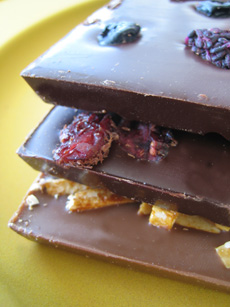 
Artisanal bars from Michael Mischer Chocolates of Oakland, California. Photo by Melody Lan | THE NIBBLE.
|
KAREN HOCHMAN’s first word was not cacahuatl...but as her mother will attest, it was pretty close.
|
|
May 2006
Revised January 2009
|
 |
From Pod to Palate: The Birth Of The Bar
Page 7: Making The Chocolate ~ Conching The Chocolate
This is Page 7 of a 10-page article on chocolate production. Click on the black links below to visit other pages.
Making The Chocolate
12. Conching
Now the chocolate is “beaten” and refined by rollers to give it a finished, smooth, silky texture. But it must be kneaded and churned one more time—this time in the conching machine. Conching is a process which removes moisture and acidity from the chocolate,  eliminates undesirable odors, fully evolves the desirable flavors and aromas and further smoothes the particles. During conching, the cocoa mass is poured into a stirring and milling machine. It is rolled, turned and aired at a temperature of about 180°F. The rollers can produce different degrees of agitation and aeration in order to develop and modify the chocolate flavors. In fact, while roasting and blending of the different beans are part of the house recipe, conching is another part of the “top secret” of each chocolate makers. The temperature, mixing regimes and length of conching vary according to formulas that create different outcomes in the chocolate. eliminates undesirable odors, fully evolves the desirable flavors and aromas and further smoothes the particles. During conching, the cocoa mass is poured into a stirring and milling machine. It is rolled, turned and aired at a temperature of about 180°F. The rollers can produce different degrees of agitation and aeration in order to develop and modify the chocolate flavors. In fact, while roasting and blending of the different beans are part of the house recipe, conching is another part of the “top secret” of each chocolate makers. The temperature, mixing regimes and length of conching vary according to formulas that create different outcomes in the chocolate.
Photo courtesy of Scharffen Berger Chocolate.
During the conching process, friction between the sugar and the cacao particles occurs. This causes further “polishing” of the cacao particles, contributing to the smooth taste of the finished chocolate. Extra cocoa butter is sometimes added to give the chocolate a better mouthfeel. Soy lecithin is also added to stabilize the chocolate, vanilla is added, and milk (if milk chocolate). The chocolate can now be cooled and tempered.
Generally speaking, the longer chocolate is conched, the smoother it will be, assuming the same machine. The process may last for a few hours to three full days, and in the case of coatings, up to six days. The time depends on the bean and the preference of the producer—Valrhona’s grand cru chocolates, Caraïbe, Jivara Lait, Guanaja and Manjari, are conched for about 5 days! However, a key differentiator is the age of the conch. New machines conch much faster than older machines. So, you can’t compare apples to oranges, e.g., how long one company conches its chocolate compared to another.
The term “conching” refers to the shell-like paddles that were originally used (today they are generally rollers, as shown in the photo). The technique was invented* in 1879 in Switzerland by Rodolphe Lindt to make chocolate more blendable (the French word is lissage) and smooth. Fine chocolate should melt in your mouth without any grainy feeling on the tongue.
*It was invented accidentally—Lindt went away for a weekend and inadvertently left a machine on that continued to stir a vat of chocolate; he returned to smooth and silky chocolate.
Continue To Page 8: Tempering The Chocolate
Go To The Article Index Above

|





 eliminates undesirable odors, fully evolves the desirable flavors and aromas and further smoothes the particles. During conching, the cocoa mass is poured into a stirring and milling machine. It is rolled, turned and aired at a temperature of about 180°F. The rollers can produce different degrees of agitation and aeration in order to develop and modify the chocolate flavors. In fact, while roasting and blending of the different beans are part of the house recipe, conching is another part of the “top secret” of each chocolate makers. The temperature, mixing regimes and length of conching vary according to formulas that create different outcomes in the chocolate.
eliminates undesirable odors, fully evolves the desirable flavors and aromas and further smoothes the particles. During conching, the cocoa mass is poured into a stirring and milling machine. It is rolled, turned and aired at a temperature of about 180°F. The rollers can produce different degrees of agitation and aeration in order to develop and modify the chocolate flavors. In fact, while roasting and blending of the different beans are part of the house recipe, conching is another part of the “top secret” of each chocolate makers. The temperature, mixing regimes and length of conching vary according to formulas that create different outcomes in the chocolate.